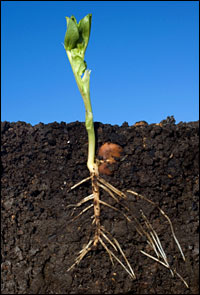Dear Umbra,
I asked about fava beans about two weeks ago, and have not had a response back. I have had no luck researching it myself, and would really appreciate a response. I asked at what point in the plant’s life did it produce nitro for the soil? For fullest nitro replenishment, should I let the plant seed? Die off? If I pull the plant out, will the nitro stay in the soil? I thank you for your time.
KLK
Aptos, Calif.
Dearest KLK,
You’ll notice that I answer two questions per week — that’s 5 percent of all of the questions that are asked. Grist has still not stated its policy on cloning employees, so although I love you all, a personal reply is often impossible at this time. That’s why, over New Year’s, I put together a little clip-and-save resources list for my dearest readers. You have a gardening question, so your local extension service or Master Gardeners is a first internet or phone stop, even before asking me.

Smile and nodule.
However, I love favas too. And because I am tackling soil health this week, I am going to answer this seemingly fava-specific question, which actually has broader implications.
First, a bit of background: favas are legumes, members of the Fabaceae family, which includes a huge number of edible and landscape plants. Legumes have various identifying characteristics (they’re dicotyledonous, with stipules, etc.); the two most obvious to the eye are the seedpod and the flower, which resemble the seedpod and flower of beans. Alfalfa, lentils, soy beans, green beans, peas, vetch … these are all legumes, as you’ll notice when they fatten their furry pods. Legumes are a key to eating less meat, as we know; they also are vital to reducing our use of fertilizers at a home and farm level.
Proper use of legumes as “green manure” or “cover” crops can help us all reduce our fertilizer inputs and build a self-sustaining garden. Nitrogen is a vital plant nutrient, but the plentiful nitrogen in the air is in a chemical form plants cannot use. Synthetic nitrogen is the original chemical fertilizer, and still today the underpinning of our unsustainable food system. It is petroleum-based and designed for quick action in the soil. It does wonders to produce green, leafy growth in plants; it does little to build the long-term soil health necessary for a sustainable, self-sustaining system.
Here is where legumes come in: their symbiotic root bacteria, Rhizobium, transforms nitrogen gas from the air into ammonia and ammonium, the forms that can be used by plants. We plant beans; they sprout and grow roots; if Rhizobium is present (or if we purchased and added inoculant when we got the seeds) it will start building little homes on the root hairs, taking nutrients from the plant roots for its own health and feeding the plant with nitrogen in return.
The little Rhizobia nodules (visible on the roots of the plant) are the key to nitrogen transformation, but most of that nitrogen is then used by the legume, stored in its leaves and stems. KLK, then, is asking how exactly to take the next step as a gardener: how do we get the nitrogen provided by these nodules to slough off into the soil and feed the rest of our crops, so that we can avoid buying fertilizer? Do not let the plant go to seed or die. The best way is to cut down the entire legume as it begins to flower. Either chop and mix it right into the soil to let it decompose, or compost it and then return it to the garden.
I hope this explains why gardening books and advisers are always harping on cover crops as part of the garden rotation. You can’t just grow beans to eat and hope they return nitrogen to the soil. They won’t — they’ve spent all their nitrogen making seeds. To build soil nitrogen with few store-bought inputs, we must dedicate part of our garden to growing legumes and then composting them.
Here lies the fava-lover’s dilemma. If you grow edible favas as a nitrogenous cover crop, you must kill them just as they start to flower, and never get to eat the beans. I say don’t do it. Either grow inedible favas for cover crop, or use a different legume. It’s just too painful to cut down delicious future dinner.
Leguminously,
Umbra

